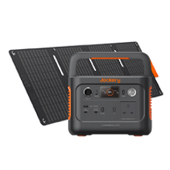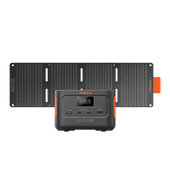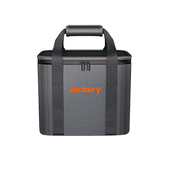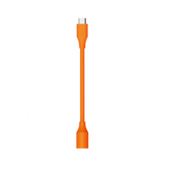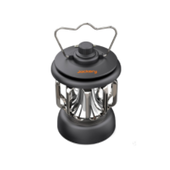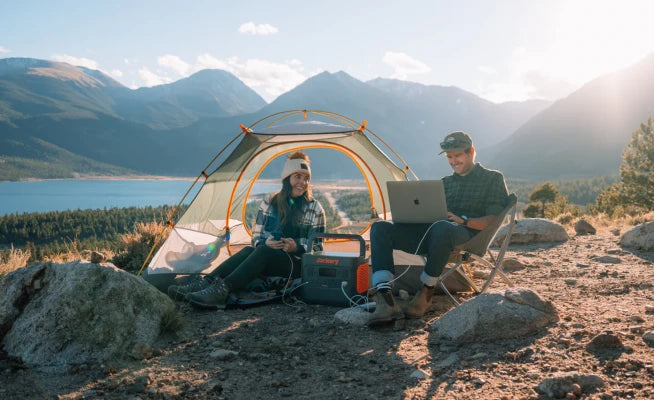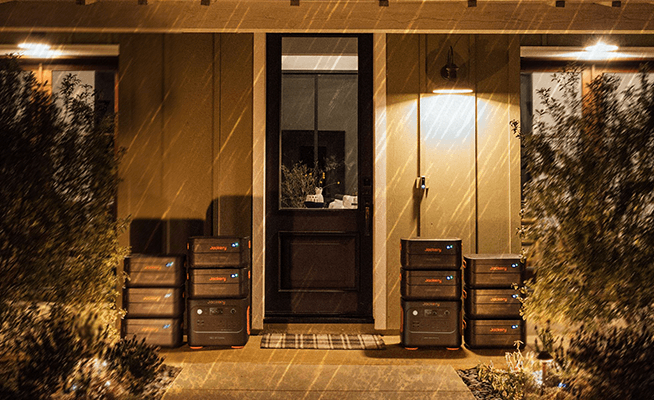From rugged mountains to rugged coastlines, Wales has a wealth of fantastic hiking trails. According to statistics, there are more than 1,368 miles (2,200 kilometres) of national trails and walks in Wales. Besides, almost all hiking trails in Wales are along beautiful coastlines, magnificent mountains, beautiful waterfalls, and excellent slate mines listed as World Heritage Sites. Even the most experienced hikers will be satisfied with the hiking trails in Wales.
In this guide, we've highlighted information about hiking in Wales. We also highly recommend Jackery Portable Power Stations, the best hiking companions with higher capacity and portability.
Key Takeaways: |
- People go hiking in Wales for well-developed hiking routes, a suitable climate and good infrastructure. - In Wales, choosing a route of appropriate difficulty is essential according to one's physical ability and experience. - When hiking in Wales, it is essential to wear the proper clothing and have professional outdoor equipment to ensure safety and comfort. - Whether you hike alone or with a group, you need to be fully prepared before hiking. - We recommend the Jackery Explorer 500 or 240 v2 portable power station to power your essentials effectively while hiking. |
Is Wales a Good Place for Hiking?
With its desolate moors and mountains, cliff-fringed coastlines and hidden valleys, Wales is undoubtedly a paradise for hiking enthusiasts. So, if you love outdoor activities, Wales has various options for you all year round. It goes without saying that if you want to go hiking, Wales has a long list of the best hiking routes. Here are some of the main reasons why people choose to go hiking in Wales.
Well-developed Hiking Routes
Wales offers a variety of hiking routes of varying difficulty through a multi-dimensional landscape of coasts, mountains, historical sites, and geological wonders. For example, the 870-mile Wales Coast Path is the first hiking trail in the world to cover a country's entire coastline. In short, Wales' hiking route network is very mature.
Suitable Climate
Although Wales' weather is changeable, its mild climate makes it suitable for hiking all year round, especially in spring, summer and autumn. Wales has a temperate maritime climate with an average annual temperature of about 8-14°C. The temperature difference between the four seasons is slight, avoiding extreme weather restrictions on hiking. In addition, Wales' mild winter climate (rarely below 0°C) also extends the hiking season.
Good Infrastructure
Wales has a complete hiking infrastructure, with clear trail signs and ample accommodation, dining, and transportation facilities, making it easy for hikers to plan their itineraries. For example, Wales' railway network (such as the Welsh Coast Line) and bus system (such as Snowdon Hikers' Bus) deeply cover the hiking area, and most starting and ending points have convenient transfer stations. Data shows that infrastructure satisfaction reached 92% in 2023 (Welsh Tourism Survey).
How to Find a Good Route to Hike in Wales?
Before embarking on a hiking trip, choosing the right trail that suits your preferences and abilities is essential.

Wales has a variety of terrain, from the dramatic rock formations of the Snowdon Mountains to cliff walks along the coastline. The difficulty, landscape, and facilities vary significantly from area to area. In Wales, you can usually choose from the following hiking locations:
• Snowdonia National Park
• Brecon Beacons National Park
• Pembrokeshire Coast National Park
• Cambrian Mountains
Choose a Route Difficulty
Wales' hiking routes cover all difficulty levels, from gentle coastal walks to challenging mountain climbs. As a beginner, you can choose a flat, well-marked, short route, such as the coastal path around Conwy Castle. Experienced hikers like Crib Goch or Glyderau on Mount Snowdon can tackle more technical routes.
Route Length and Time Planning
Wales hiking routes range from short, leisurely hikes to multi-day challenges. If you want to experience a single-day hike, Miners' Track (5 hours) and Watkin Path (4-5 hours) are good choices. But if you want to experience a multi-day hike in Wales, consider the National Trails of Wales, such as the Pembrokeshire Coast Path (186 miles, 7-14 days).
Ways to Find a Good Hiking Route in Wales
"How do you find that perfect hiking route?" is a common question for many, especially beginner hikers. Here are some easy ways to find the best hiking routes.
Google: Google is often the best place to find hiking routes. For example, you can use Google to search for "best hiking routes in Wales" to find the best hiking routes.
AllTrails: AllTrails provides information on almost all hiking routes in Wales, including location, distance, difficulty, altitude, route type, and other details. You can also read user reviews from those who have experienced them and get more helpful information, such as whether there is parking near Llanberis Path.
Local Tourist Information Center: You can go to the tourist information centre in Wales and ask them for a map of the hiking route and some recommended routes.
The 10 Best Hiking Routes in Wales
Whether looking for a stroll or a walking adventure, Wales has a walking route to suit your needs. Here are six of Wales's most popular hiking routes, ranging from lesser-known adventures to absolute classics.

Rhaeadr Fawr (Aber Falls)
Distance: 4.2km
Altitude: 167m
Estimated Time: 1h 19m
Difficulty: Moderate
Rhaeadr Fawr is a well-maintained, moderately strenuous hike with a steady ascent. Along the way, you'll see deep valleys, beautiful Rhaeadr Fawr and the remains of an old Iron Age settlement, the Aber Valley Hut Circle.
Llyn Idwal Circular
Distance: 4.8km
Altitude: 248m
Estimated Time: 1-2 Hours
Difficulty: Moderate
Llyn Idwal Circular is located in the Ogwen Valley and rises gently to the base of the steep peaks of the Glyderau Mountains. This moderately challenging route around Llyn Idwal offers stunning scenery and an idyllic atmosphere. Llyn Idwal Circular, near Llanberis in Gwynedd, is also popular for bird watching, camping and fishing. This scenic route is highly recommended if you're a novice hiker who wants a peaceful day in nature.
Pen y Fan Circular
Distance: 7.4km
Altitude: 537m
Estimated Time: 3h 11m
Difficulty: Hard
Located near Brecon in County Powys, the Pen y Fan Circular is arguably one of the most popular walks in Wales. It takes you to the peaks of Corn Du and Pen Y Fan, with stunning panoramic views of the surrounding mountains and Bannau Brycheiniog National Park. The scenery along the Pen y Fan Circular is lovely when the weather is clear. However, due to its popularity, it can be very crowded during peak times, such as in the summer.
Y Garn via Devil's Kitchen Circular
Distance: 7.6km
Altitude: 706m
Estimated Time: 3-4 Hours
Difficulty: Hard
If you want to experience the Y Garn via Devil's Kitchen Circular, the best time to do it is from January to October. The Devil's Kitchen results from steam that sometimes rises from a large crack in the cliffs between Glyder Fawr and Y Garn. It is a scenic, challenging climb and a popular route to the tenth-highest peak in Wales.
Four Waterfalls Walk
Distance: 8.5km
Altitude: 307m
Estimated Time: 2h 34m
Difficulty: Hard
Each waterfall has its charm and characteristics, and spring and autumn are the best seasons to see them. However, the descent to the waterfalls and the sudden drop will likely be tricky and slippery, so it is best to try this walk in dry weather. The Four Waterfalls Walk is open all year round and suitable for walkers of all levels.

Moel Siabod Circular
Distance: 10.1km
Altitude: 764m
Estimated Time: 4-5 Hours
Difficulty: Hard
If you want to take your family or friends to experience the Moel Siabod Circular, January to September is the best time. It starts from the Bryn Glo car park near Pont Cyfyng and takes you to the highest peak of the Moelwynion Mountains (Moel Siabod). If the weather is clear, you can enjoy the magnificent views of the Eryri Mountains and Cyfyng Falls along the way.
Moel Famau Circular
Distance: 11.3km
Altitude: 416m
Estimated Time: 3h 26m
Difficulty: Moderate
A popular mountain, Moel Famau, is 555 metres high, with its highest point being Moel Famau. Once you reach the top, you will be rewarded with sweeping views of the Jubilee Tower and the summit of Moel Famau. However, the Moel Famau Circular can be steep, rugged, muddy, and slippery, so please be careful.
Dragon's Back Circular
Distance: 11.6km
Altitude: 816m
Estimated Time: 4h 54m
Difficulty: Hard
Dragon's Back Circular is a challenging hike that starts in the small village of Pengenford within the Brecon Beacons National Park. It is popular with most outdoor enthusiasts due to the beautiful Black Mountains. However, this hike has some steep and rugged sections that require extreme caution.
Pen Y Fan Horseshoe
Distance: 14.8km
Altitude: 785m
Estimated Time: 5h 21m
Difficulty: Hard
Located near Merthyr Tydfil, Pen Y Fan Horseshoe is generally considered challenging. While the route does have some pretty steep sections, it is typically not very technical or demanding on your fitness level. This quiet circular horseshoe trail involves walking along the ridgeline around the scenic valley. On a clear day, the scenery along Pen Y Fan Horseshoe is beautiful, with bright green valleys and weathered peaks.
Yr Wyddfa (Snowdon) via Llanberis Path
Distance: 14.8km
Altitude: 985m
Estimated Time (round trip): 6h 3m
Difficulty: Hard
The Llanberis Path is the longest path to the summit and is considered the easiest way to climb Yr Wyddfa (Snowdon). As such, it is the most popular of the main routes up Yr Wyddfa, especially for families, groups and first-time climbers. For example, more than 40% of Yr Wyddfa hikers choose this route. Most of the Llanberis Path is well-designed and well-maintained, with only a short section near the summit that is slightly steep. Although the path is steep in some places, it is vast, and there is no need to worry about it.
What Should You Wear and Bring When Hiking in Wales?
Due to the varied terrain (mountainous, complex coastline) and unpredictable weather when hiking in Wales, it is recommended that you adopt a "layering method" and equip yourself with professional outdoor gear to ensure safety and comfort.
What Should I Wear When Hiking in Wales?
Knowing what to wear when hiking in Wales is essential because wearing the wrong clothes can at least ruin your entire hiking experience. Due to the terrain (mountainous, complex coastline) and unpredictable weather, it is recommended that you adopt a "three-layering method" and equip yourself with professional outdoor gear to ensure safety and comfort.
Below is a guide to what to wear for hiking in Wales.
Upper Part: When hiking in Wales, the key to dressing the upper body is to wear multiple layers (usually three) so they are easy to put on and take off.
Inner layer (sweat-wicking layer): clothes made of quick-drying materials.
Middle layer (warmth layer): fleece, light down jacket or wool sweater.
The outer layer (protective layer) is a jacket.
Lower Part: Walking pants or sweatpants that can be unzipped into shorts are perfect. Pack waterproof outer trousers to keep you warm and dry if you know it will be wet.
Feet: For hiking in Wales, it's highly recommended that you choose a pair of medium-high-top waterproof hiking boots that provide ankle support and are non-slip. If your hiking shoes are new, try to break them in before your hike until they fit you properly.
Also, wear sweat-wicking socks rather than cotton socks, and have a spare pair.
Other Accessories: In addition to a top, trousers and shoes, you may need different accessories to keep you warm, protect you from the wind or enhance your hiking experience.
Hat
Sunglasses
Gloves
Neck warmer
Bring enough warm clothing for hiking along the Welsh coastline (tidal) or in the mountains (temperatures drop sharply at night).

What Should You Pack for a Hike in Wales?
What you pack for a hike in Wales will depend on several factors, such as the number of days you'll be there and the type of weather you expect. Below is a comprehensive hiking packing list of items you may want to bring on a hike.
A Packing List for Hiking in Wales | |
Backpack Dry bag Map Compass or GPS device Hiking poles Flashlight Extra clothing Portable shelter (if needed) | High-calorie food Water bottle or hydration bag Anti-bacteria tablets or water filter Survival whistle Sunscreen First aid kit Cash Portable power station |
This list is for reference only.
In short, when preparing hiking items, avoid unnecessary items and prioritise essential items and multi-functional equipment. In addition, please further adjust the packing list according to the specific itinerary (such as the duration of the trip, the season, and personal needs).
Jackery Portable Power Stations for Hiking
Portable power stations have become increasingly helpful for hiking and outdoor adventures, providing a reliable power source in remote locations. A charged phone is essential for getting in touch in an emergency. Thanks to portable power units, you can stay in touch even when there isn't a utility grid nearby. GPS devices and smartphones need the power to find the way. With a compact power station, these critical tools will never run out of power.
A Jackery Portable Power Station is a small, battery-powered gadget that lets you get power on the go. It has AC, DC, and USB ports to run most outdoor electronics and devices, such as your phone, GPS, smartphone, etc. It's quieter than gas engines, doesn't emit pollution, and can be charged by solar panels, wall outlets, or car chargers.
Jackery Explorer 240 v2
The Explorer 240 v2 Portable Power Station features a substantial 256Wh capacity within a compact framework. This device features 1 AC outlet, 1 USB-A port, and 1 USB-C port, enabling the simultaneous charging of up to 5 devices, thereby facilitating the rapid and efficient powering of multiple appliances.
The Explorer 240 v2 Portable Power Station achieves a full charge from 0% to 100% in one hour when the Emergency Charging Mode is activated through the app and prepared for emergencies with a portable power supply, guaranteeing a continuous power source while travelling.
The Jackery Explorer 240 v2, weighing 7.94 lbs and has a compact foldable handle, offers enhanced portability compared to conventional products, allowing for easy storage in a backpack. The transition from an NCM to an LFP battery results in a notable enhancement, offering 3,000 life cycles and a lifespan of up to 10 years, making it a dependable option for outdoor camping and adventures.
- Easily Fits into Backpack: The smallest 300W among mainstream brands, Foldable Handle and Buckle, is perfect for hiking. You can charge whenever you need to.
- 5 Ports & 1 Hour Flash Charging: This product now features USB-C input and output enabled, 100W two-way fast charging.
- Longer Battery Lifespan: We upgraded to an LFP from an NCM battery with 3,000 life cycles and 10 years of household emergency backup.
- Safe and Reliable: IEC Certified Safety, 52 Protection Mechanisms, Upgraded ChargeShield 2.0.

Jackery Explorer 500
The Jackery Explorer 500 Portable Power Station can charge various hiking electronics, from low to high power, for extended durations. It has a substantial battery capacity of 518Wh, a foldable handle, an ergonomic design, and advanced BMS technology, making it suitable for hiking. The item weighs only 13.32 lbs, facilitating ease of transport.
The Jackery Explorer 500 Portable Power Station includes one AC outlet, two DC ports, one carport, and three USB-A ports, enabling the charging of various appliances, such as GPS devices, portable fans, mini-refrigerators, and others. The power station's compact size and lightweight design render it ideal for hiking in Wales.
The Jackery Explorer 500 eliminates the need to locate a wall outlet for recharging. Various charging methods, including solar panels, car outlets, and electric generators, allow devices to be charged in diverse locations at any time.
The Jackery Explorer 500's most notable characteristic is its extended battery life. After 800 charge cycles, the power station retains 80% of its battery capacity.
Large Capacity: The Jackery Explorer 500 has a 518-watt-hour (24Ah, 21.6V) lithium-ion battery pack and a pure sine wave inverter.
Multiple Ports: It features 1* AC outlet (230V 500W 1000W peak), 3* USB-A ports, 2* DC ports, and 1* carport to run low-to-high appliances.
Designed for Portability: The Jackery Explorer 500 portable power station is about the size of a basketball and has a solid handle.
Paired with Jackery Solar Panels: The Explorer 500 has a high-quality built-in MPPT charge controller. When paired with the Jackery SolarSaga 100W solar panel, this allows quick and easy green solar recharging.

Is It Better to Hike Alone or in a Group in Wales?
Wales is known for its magnificent natural scenery and diverse hiking routes. Whether to hike alone or with a companion is a matter of personal preference, experience level, and safety.
Advantages of Hiking Alone
There are several advantages to hiking alone in Wales.
• Solo hikers can flexibly adjust their routes and rest time.
• Hiking alone can help you improve your independent decision-making ability and outdoor skills.
Disadvantages of Hiking Alone
There are several risks associated with hiking alone in Wales.
• Facing lousy weather (such as heavy rain, strong winds, and fog) and complex terrain (steep slopes and swamps), you will lack the support of companions when you get injured or get lost, and it will be challenging to seek help in time.
• Being alone for a long time may cause psychological discomfort, especially for those without solo hiking experience.
Advantages of Hiking with a Companion
The following are the advantages of hiking with a companion in Wales:
• When hiking with a companion, some experienced hikers can provide route advice and local knowledge, reducing the risk of getting lost or straying into dangerous areas.
• Wales has complex terrain (such as mountains, coastal cliffs, etc.), and walking with a companion can reduce the risk of getting lost and injured.
• Hiking with a companion allows you to share beautiful scenery and take photos with each other, which is suitable for beginners or travellers who prefer a group atmosphere.
Disadvantages of Hiking with a Companion
The following are the risks you may face when hiking with a companion in Wales:
• Different physical fitness levels among teammates may cause delays and sacrifice some freedom since some hiking routes in Wales are physically demanding.
• Hiking with a companion is likely to cause conflicts of opinion, especially in route selection, dining preferences or activity priorities.
• Over-reliance on companions may reduce personal vigilance and lead to insufficient personal preparation.
If you are a novice or have limited experience, please prioritise walking with a companion or joining a guided group to ensure safety and professional guidance. However, if you are an experienced hiker (or someone with sufficient outdoor experience) and prefer to explore independently, you can choose to hike alone.
Hiking in Wales FAQs
The following are the frequently asked questions about hiking in Wales:
Where is it good to walk in Wales?
The following are some of the most popular spring walks in Wales:
A gentle walk at Plas Newydd (1.6km)
'Capability' Brown walk at Dinefwr (2.4km)
Colby Woodland Garden walk (3.47km)
Aberglaslyn, Bryn Du and Beddgelert walk (5.6km)
2. What is the best time of year to hike in Wales?
In Wales, the best time of year to hike is summer (June-August) and autumn (September-November). The weather in Wales in summer is sunny and stable, so it is suitable for extended outdoor activities. The weather in Wales in autumn is mild, and the natural scenery is the most beautiful, ideal for photography and leisure hiking. In Wales, the winter (December-February) and spring (March-May) weather is changeable, and rainfall is frequent, which may affect the comfort of hiking.
3. What is the best mountain to hike in Wales?
According to the feedback from most outdoor enthusiasts, Snowdon Horseshoe is the best mountain to hike in Wales.
4. What is the app for hiking in Wales?
In Wales, the app most people refer to for hiking is Llwybrau'r Wyddfa Walks App.
Final Thoughts
Not only do hiking routes in Wales vary in difficulty, but they also guarantee stunning views, from towering mountain peaks to idyllic coastlines. So, for most outdoor enthusiasts, Wales is undoubtedly a great place to go hiking. Besides worrying about finding a good hiking route, you must also consider what to wear and bring. In short, plan the perfect hiking trip in Wales with this guide.












